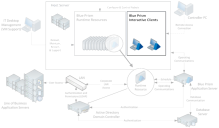Blue Prism interactive client
Blue Prism interactive client
Interactive clients are used for developing processes and for controlling and monitoring the Blue Prism runtime resources. The core purpose and features offered by an interactive client is dependent on whether it is used in a development or production environment (or both).
Hub Control Room can also be used for controlling and monitoring runtime resources, in addition to other functions. See Blue Prism Hub Control Room for details.
Minimum requirements: interactive client
The latest information about the minimum specifications of each Blue Prism component can be found in Blue Prism software and hardware requirements.
All minimum requirements must consider the selected operating system as well as the applications to be automated. Interactive clients can either be deployed to existing user desktops or to a virtualized end-user desktop instance.
Each interactive client requires the Blue Prism application to be installed. Where the interactive client is used for developing and configuring Blue Prism processes, consideration should be given to the installation of and connectivity to target applications; and access must be granted to all in-scope applications.
Frequently asked questions: interactive client
How are interactive clients typically deployed?
It is recommended that interactive clients used by Blue Prism process developers are configured using the same specification as runtime resources, this is commonly a virtualized machine. Controller machines can be deployed on user’s physical desktops or virtualized.
What are the security implications of this component?
Interactive clients must be secure, with only authorized users allowed to access the hardware and application. Developers working on interactive clients can modify processes and access credentials used by those processes. It is therefore recommended that role-based access control (RBAC) is implemented such that no users in production environments have permission to open and edit processes or objects. It is also recommended that in pre-production environments where developers are necessarily editing processes, credentials used by those processes correspond to pre-production instances of target applications, rather than production credentials which developers should not have access to.
To strengthen Blue Prism network security, role-based access control (RBAC) should be utilized and only specific users, such as infrastructure administrators, should be granted access to application servers and network communication configuration. All other users should be denied access by default. Explicit allow/deny access should be configured for all users and the principle of ‘Least Privilege’ followed. These controls should also extend to the users of Blue Prism, so that only those who need access to the platform are allowed and are only given the level of authority required to carry out their role, while all others are denied access by default.
Can a single interactive client be used across multiple environments?
Irrespective of whether the device is provisioned physically or virtually, a single interactive client can be configured to connect to multiple Blue Prism environments of the same version (e.g. Dev/Test/Production). The user selects which environment they wish to connect to as part of the logon procedure.
Does this component need to be backed up?
Typically there is no important information or configuration stored on a Blue Prism interactive client unless a local database is in use (e.g. for development purposes), which we strongly advise against. It is however recommended that where possible a clone of the client should be retained.
Networking: interactive client
The main components that interactive clients initiate communications with include:
- Application server – The application server is used for all database connectivity (WCF) and also to send instructions to runtime resources (TCP).
- Third-party applications – See Blue Prism runtime resource for network considerations where the interactive client is used for developing and configuring processes.




No comments